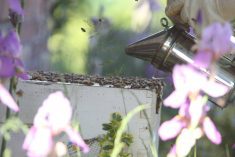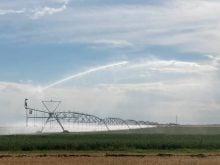UPDATED: Friday August 11, 2023 – 1100 CST – Video added. – Watershed council directors who manage two of the largest waterway systems in southern Alberta say the Bow and Oldman rivers will struggle to provide water to irrigators if present conditions persist.
They said the rivers can currently deal with the lowest water levels seen in two decades, but there are limits.
Water shortage advisories have gone out for 11 tributaries for that feed into the Bow and Oldman.
Downstream where the water bodies combine to form the South Saskatchewan River, recorded flow rates are well below the lower historical amounts.
Mike Murray, Bow River Basin Council executive director, said his and other watershed councils made up of municipalities, irrigation districts and ecological organizations came to prominence after a moratorium was placed on new water licences on the South Saskatchewan River basin in 2006.
While irrigators make up about 70 percent of the water allocated along the Bow, there is sometimes a perceived disconnect between water allocated and that which is actually used. He added it’s rare to see required allocations not be met with lots left over.
“But even in 2006… (irrigation districts) expected those allocations would be used more over time and especially in times like we’re having right now,” he said.
But defining the carrying capacity of the river to support irrigators, municipalities and industry is still an open question, said Murray.
“It may be as climate change takes over that even that carrying capacity changes over time,” he said, highlighting the timing of the spring melt this year occurred in May, a month earlier than usual.
“It’s been recognized this is the driest year we’ve had since 2001. (That) was the real stress test and we are having another one of those. We’re learning what the carrying capacity might be and where the limits may be.”
Murray said while the Bow River isn’t under a water advisory, important tributaries such as the Elbow and Sheep rivers do have an advisory because of lack of rain and a less than average snowpack that melted quickly during a spring heat wave.
The Bow can deal with lighter than usual runoff because there are multiple sources that feed it, but for tributaries such as the Elbow and Sheep, “a small change in their flow can sometimes mean a big difference in either the temperature or water quality or many other aspects that are necessary for a healthy ecosystem.”
Murray said there is much to learn about the downstream effects of those tributaries when they run dry.
“We’re still trying to develop methodologies and processes to identify when there is a problem and is that trend increasing or decreasing,” he said.
Understanding the rivers’ abilities to provide water to cities, agri-food processing and industry is becoming more important as all three sectors seek expansion.
While the investments to expand irrigation infrastructure continue, Murray stressed that may extend the ability to deal with prolonged dry conditions but it’s not a complete solution.
“Building new infrastructure doesn’t mean there is more water. The water we work with is finite. That’s all there is. You can’t create water by creating a structure,” he said.
When it comes to prolonged dry conditions, the system will continue to strain to meet demands.
Shannon Frank, Oldman Watershed Council executive director, warned there is precedent in the historical record of long periods of drought in southern Alberta stretching into the decades.
She echoed Murray’s comparison of this year to 2001 when irrigators along the Oldman had to cut water allocations.
Frank also highlighted concerns about the state of some of the Oldman’s tributaries, specifically Willow Creek.
“Over the last three years, it’s been basically drying up from low precipitation but also irrigation,” she said. “It’s become a common occurrence in some creeks and rivers that not everybody is getting the water they need.”
Frank said irrigation districts decide whether to expand, and by how much. The process requires a members’ vote and the risks associated are known.
That situation came into sharp focus this year with the St. Mary’s River and Eastern Irrigation districts allotting a less than normal volume with the latter organization even temporarily cutting back on that amount at one point.
“The big concern for a long-term drought is we can’t fill those reservoirs. If there is a long-term drought, there just isn’t going to be any water in them,” she said. “That would hit our economy hard and our farmers and ranchers…. It doesn’t take many years before there is a catastrophe.”
Frank said 2001 was a hard year for agriculture because it followed a dry year, and “that was only year two. So, if it lasted three, four or five years, it would be catastrophic for this sector.
“Unfortunately, we live in a place where that is not uncommon.”
Frank said historical data collected from tree rings has shown there have been 50-year droughts in the region in the past, though the 1930s was the last time a prolonged drought has hit southern Alberta.
“We really have to think about that and how can we plan and prepare to minimize the damage because if we have a more than two season drought, there are going to be severe impacts,” she said.
As part of an inter-provincial water sharing arrangement, 50 percent of the South Saskatchewan River’s flow must be allowed to proceed into the waterbody’s namesake province. That flow has been bolstered by the Red Deer River, which joins the South Saskatchewan just before the provincial border.


















